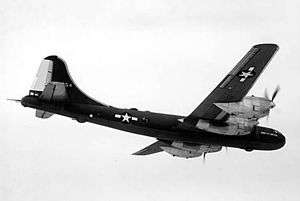Boeing XB-39 Superfortress
| XB-39 Superfortress | |
|---|---|
 | |
| Boeing XB-39 serial number: 41-36954 | |
| Role | Heavy bomber |
| Manufacturer | Boeing |
| First flight | 1944 |
| Primary user | United States Army Air Forces |
| Produced | 1944 |
| Number built | 1 |
| Developed from | Boeing B-29 Superfortress |
The Boeing XB-39 Superfortress was a United States prototype bomber aircraft, a single example of the B-29 Superfortress converted to fly with alternative powerplants. It was intended to demonstrate that the B-29 could still be put into service even if the first choice of engine, the air-cooled Wright R-3350 radial engine, ran into development or production difficulties.
Design and development
Starting life as the first YB-29 delivered to the United States Army Air Forces, it was sent in November 1943 to the Fisher Body Aircraft Development Section of General Motors to be converted to use Allison V-3420-17 liquid-cooled W24 (twin-V12, common crankcase) inline engines.[1] Fisher was chosen for the modification as it was familiar with the engine, as it was to power the P-75 Eagle that they were then developing. Testing on it began in early 1944.
Further development of the engine and the aircraft was delayed by a series of changes in the planned turbosuperchargers, as the originally specified GE Type CM-2 two-stage turbosupercharger became unavailable due to demands on GE's production of its other turbosuperchargers. Other turbosuperchargers were considered, but the end result was that the first flights of the B-39 had to be made without any turbosuperchargers at all.
In addition, in early 1944, due to a sudden realization from the U.S. Army Air Forces that it required a long range air superiority fighter, Fisher was directed to focus on its other major project, the P-75 Eagle. In June 1944, Fisher received a contract for 2,500 P-75s. However, in October 1944, for a variety of reasons, the P-75 was canceled.
Operational history
.jpg)
Fisher finally focused again on the B-39. The first flight of the B-39 was made on 9 December 1944 at Cleveland, Ohio. The initial flight tests of the B-39, without turbosuperchargers installed, were impressive. However, the B-39 program was by now seriously delayed, and the flawed R-3350 B-29s had already been rushed into combat in June 1944.
Despite continuing problems with the B-29s, the aircraft was functioning well enough in combat that it no longer made any sense to shift resources in the manufacturing base to a new engine for the B-29 and so the B-39 was not ordered into production.
Specifications (XB-39)
General characteristics
- Crew: 10: pilot, co-pilot, flight engineer, bombardier, navigator, radio operator, side gunners (two), top gunner, and tail gunner
- Length: 99 ft 0 in (30.18 m)
- Wingspan: 141 ft 3 in (43.05 m)
- Height: 27 ft 9 in (8.46 m)
- Wing area: 1736 ft² (161.3 m²)
- Empty weight: 74,500 lb (33,800 kg)
- Loaded weight: 120,000 lb (54,000 kg)
- Max. takeoff weight: 133,500 lb (60,560 kg)
- Powerplant: 4 × Allison V-3420-11 liquid-cooled W24 (double-vee) engines, 2,100 hp (1,600 kW) each
Performance
- Maximum speed: 405 mph (351 knots, 648 km/h)
- Range: 6,290 mi (5,460 nm, 10,060 km)
- Service ceiling: 35,000 ft (11,000 m)
- Wing loading: 69.12 lb/ft² (337.5 kg/m²)
- Power/mass: 0.073 hp/lb (121 W/kg)
Armament
- Guns:
- 8× .50 in (12.7 mm) Browning M2 machine guns in remote controlled turrets
- 2× .50 in (12.7 mm) machine guns in manual turrets
- 1× 20 mm (0.787 in) M2 cannon in tail
- Bombs: 20,000 lb (9,000 kg)
See also
- Related development
- Related lists
References
- Notes
- ↑ Flying Magazine,August 1945, p. 51.
- Bibliography
- Jones, Lloyd S. U.S. Bombers, B-1 1928 to B-1 1980s. Fallbrook, California: Aero Publishers, 1962, second edition 1974. ISBN 0-8168-9126-5.
- Whitney, Daniel. Vee's For Victory!. Atglen, Pennsylvania: Schiffer Military History, 1998. ISBN 0-7643-0561-1
External links
| Wikimedia Commons has media related to XB-39 Superfortress. |